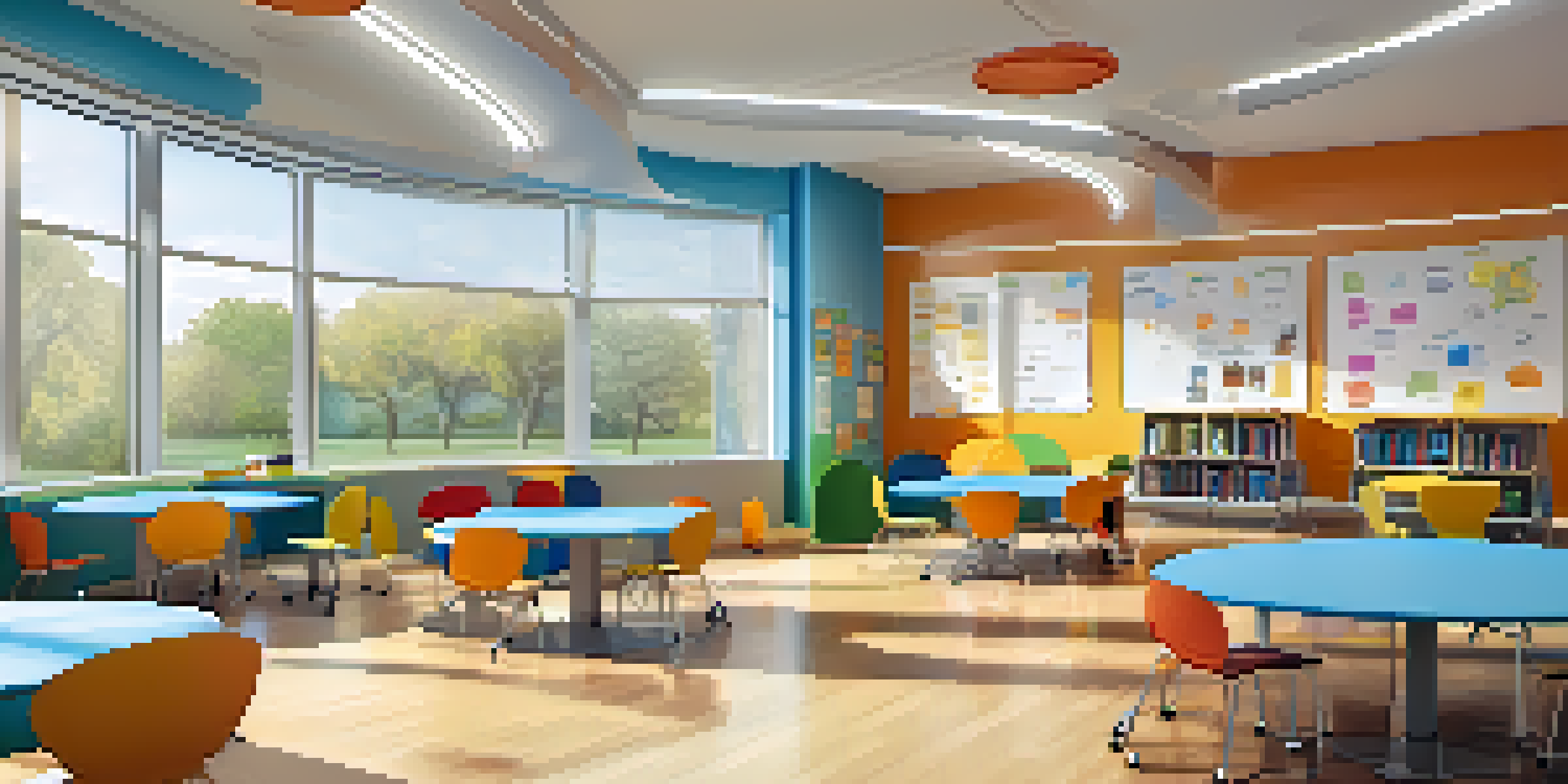The Impact of Learning Environments on Student Achievement

Understanding Learning Environments and Their Types
Learning environments encompass the physical, social, and pedagogical settings where education occurs. These can range from traditional classrooms to online platforms, each influencing how students engage with content. For instance, a well-lit, organized classroom can enhance focus, while a cluttered space might distract students.
The environment is the teacher.
Moreover, the type of learning environment can significantly affect student interactions. Collaborative settings encourage teamwork and communication, while independent study areas may foster self-discipline and autonomy. Thus, the design of these environments plays a crucial role in shaping student experiences.
In essence, recognizing the different types of learning environments is vital for educators aiming to optimize student achievement. By understanding how each environment functions, teachers can tailor their approaches to meet diverse learning needs.
The Role of Physical Space in Student Learning
The physical layout of a learning space can greatly impact how students learn. For instance, classrooms arranged in a circle promote discussion and collaboration, while rows of desks may encourage individual work. This arrangement can influence not just student engagement but also their ability to absorb information.

Additionally, elements like lighting, temperature, and noise levels also play critical roles. A bright, comfortable room can help maintain students' focus, while excessive noise might hinder their ability to concentrate. Therefore, creating an optimal physical environment is essential for maximizing student achievement.
Impact of Learning Environments
Different types of learning environments, from physical layout to social dynamics, significantly influence student engagement and academic success.
Ultimately, the design of physical spaces should align with educational goals. By being mindful of how these factors affect learning, educators can create environments that enhance student performance and well-being.
Social Interactions and Their Impact on Learning
Social interactions within learning environments significantly influence student achievement. When students collaborate with peers, they share diverse perspectives, which can deepen understanding and enhance critical thinking. For example, group projects encourage students to work together, fostering essential social skills and a sense of community.
Education is not the filling of a pail, but the lighting of a fire.
Moreover, supportive relationships with teachers can also boost student motivation. When educators create an inclusive atmosphere, students are more likely to participate actively and feel valued. This sense of belonging can lead to improved academic performance and overall satisfaction with the learning experience.
In summary, the quality of social interactions in a learning environment plays a crucial role in shaping student outcomes. By fostering positive relationships and collaborative opportunities, educators can enhance their students' learning experiences.
Technology's Role in Modern Learning Environments
In today’s digital age, technology is a key component of effective learning environments. Tools like interactive whiteboards and online resources can engage students in ways traditional methods may not. For instance, using educational apps can make learning more interactive and personalized.
Furthermore, technology can facilitate communication and collaboration among students and teachers. Virtual platforms allow for real-time feedback and discussion, breaking down geographical barriers and fostering global connections. This accessibility can enrich the learning experience and broaden students' horizons.
Technology Enhances Learning
Integrating technology in educational settings can create more interactive and personalized learning experiences while fostering collaboration.
However, it's important to balance technology use with traditional teaching methods. While tech can enhance learning, it should complement, not replace, face-to-face interactions. By integrating technology thoughtfully, educators can create dynamic learning environments that cater to diverse learning styles.
Cultural Influences on Learning Environments
Cultural backgrounds significantly shape how students engage in learning environments. Different cultures may emphasize collective success over individual achievement, affecting group dynamics and participation. Understanding these cultural nuances can help educators create more inclusive and effective learning spaces.
Moreover, incorporating culturally relevant materials can enhance student engagement. When students see their culture reflected in the curriculum, they are more likely to connect with the content, leading to deeper learning. This approach not only supports academic achievement but also fosters respect for diversity.
Ultimately, recognizing and valuing cultural influences is essential for creating equitable learning environments. By embracing these differences, educators can support all students in reaching their full potential.
Emotional Well-Being and Academic Success
Emotional well-being is closely linked to student achievement, making it essential to consider in learning environments. Stress and anxiety can hinder a student's ability to focus and perform academically. Therefore, creating supportive environments that prioritize mental health can lead to improved outcomes.
For example, implementing mindfulness practices or providing resources for emotional support can help students manage stress. Additionally, fostering a positive classroom atmosphere encourages students to express their emotions and seek help when needed. This emotional safety can significantly enhance their overall learning experience.
Cultural and Emotional Factors Matter
Recognizing cultural influences and prioritizing emotional well-being are essential for creating inclusive learning environments that support student achievement.
In conclusion, addressing emotional well-being in educational settings is crucial for student success. By prioritizing mental health, educators can create environments where students thrive academically and personally.
Designing Future Learning Environments for Success
As we look to the future, designing effective learning environments requires a thoughtful approach. Educators must consider the diverse needs of students and how various factors influence their learning experiences. This includes creating flexible spaces that can adapt to different teaching methods and learning styles.
Collaboration with architects and designers can also enhance the physical aspects of learning environments. By integrating natural light, open spaces, and technology, we can create settings that promote engagement and creativity. This holistic approach ensures that the environment aligns with educational goals.

Ultimately, the key to successful learning environments lies in continuous improvement and adaptation. By actively seeking feedback and making adjustments, educators can create spaces that foster student achievement and well-being for years to come.